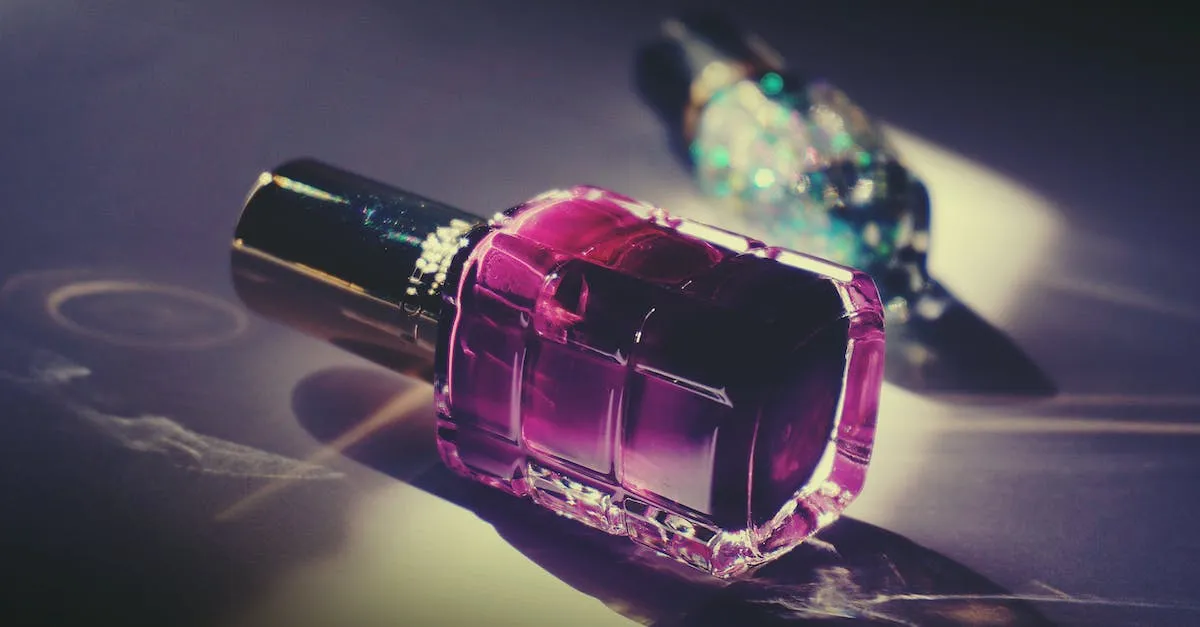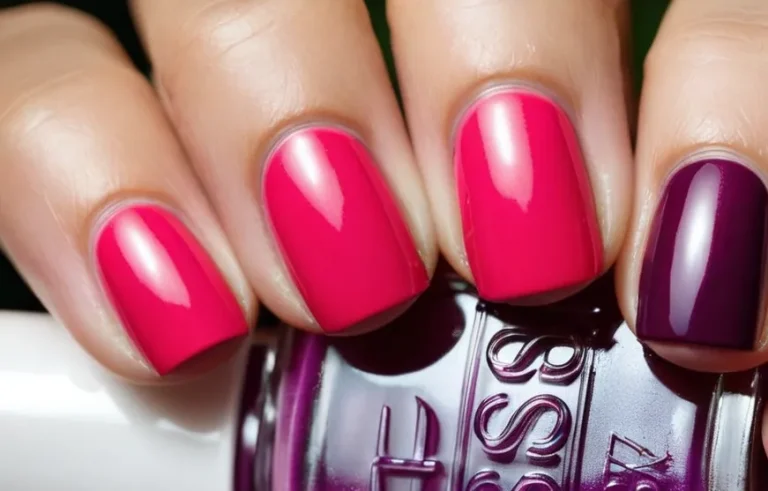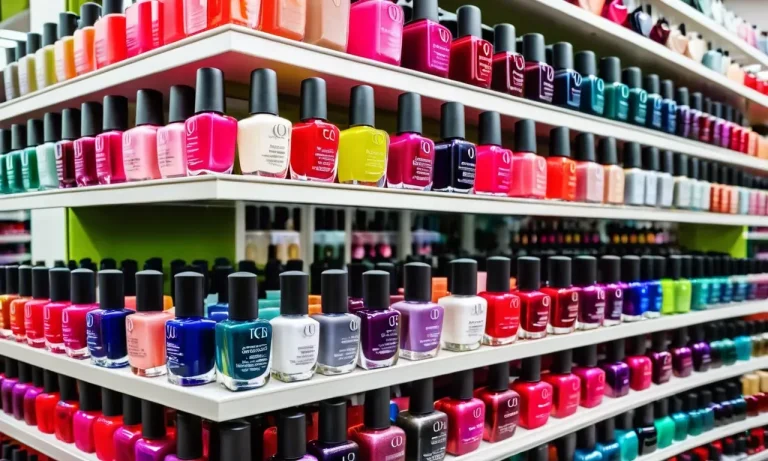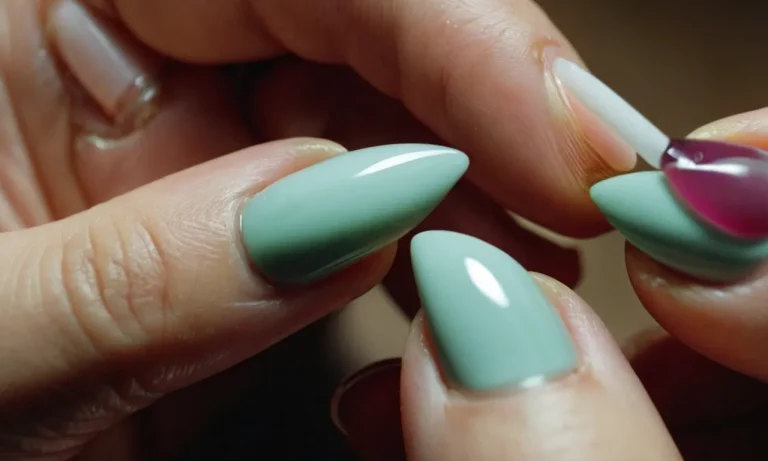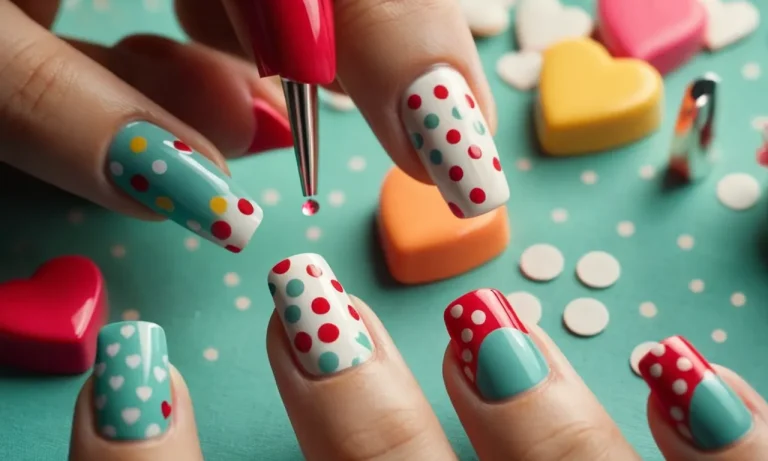What Is A Nail Tech? A Comprehensive Guide
If you’ve ever gotten a manicure or pedicure at a salon, chances are a nail tech took care of your nails. Nail techs, also known as manicurists or nail technicians, are professionals who specialize in taking care of clients’ fingernails and toenails.
In this comprehensive guide, we’ll cover everything you need to know about what a nail tech is and does.
If you’re short on time, here’s a quick answer: A nail tech is a specialist who provides manicures, pedicures, artificial nail services, and other nail care treatments to clients in salons or spas.
What Does a Nail Tech Do?
A nail technician, often shortened to nail tech, is a licensed professional who specializes in the care and decoration of fingernails and toenails. Their main responsibilities involve providing manicures and pedicures, applying artificial nails, performing nail art, recommending products and treatments, sanitizing equipment, and consulting with clients on nail health and appearance.
Provide Manicures and Pedicures
One of the core services a nail tech offers is manicures and pedicures. This involves shaping and buffing the nails, removing dead skin and calluses from the hands and feet, massaging the skin, and applying nail polish.
Nail techs use specialized tools like cuticle nippers, nail clippers, foot files, and nail buffers to perform these services. They also give hand and foot massages using lotions and creams designed to moisturize the skin and nails.
Many nail salons offer upgraded manicure and pedicure options such as hot stone massages, sugar scrubs, paraffin wax treatments, and eyelash extensions or tinting. Nail techs stay up-to-date on the latest trends and techniques for enhancing the nail care experience.
Apply Artificial Nails
Nail technicians also specialize in the application of artificial nails, including acrylics, gels, dip powders, and nail wraps. The average service time to apply a full set is 60-90 minutes. Artificial nail services involve:
- Shaping the natural nail
- Applying dehydrator and primer
- Brushing product on and shaping it with forms
- Filing, shaping and smoothing
- Applying activator or UV gel setter
- Cuticle care and moisturizing
Nail techs must have expertise using an electric nail file, proper handling of chemicals, and precision in application to ensure longevity of the manicure and safety of the client’s nails.
Perform Nail Art and Designs
If a client wants to jazz up their manicure, a nail tech can provide customized nail art and designs. Using striping tape, rhinestones, glitter, decals, stamps, and hand-painted art, nail technicians can create any look a client requests.
Popular nail art styles include French manicures, chrome or holographic powders, Halloween looks, bridal designs with lace or crystals, and more.
Exceptional nail art skills require creativity, steady hands, and specialized tools like very fine-tipped art brushes. Many nail salons display photos, samples, or have books available so clients can choose a design that fits their personal taste and style.
Recommend Products and Treatments
During appointments, nail techs will also recommend specialized products and treatments intended to remedy nail conditions or damage and improve appearance. For example:
| Nail ridges or discoloration | Vitamin E cuticle oil |
| Brittle, peeling nails | Nail strengthening polish or acrylic |
| Dry, cracked skin | Exfoliating scrub |
They stay knowledgeable about new offerings that can enhance the services they provide. Many nail techs sell retail products like lotions, callus removers, nail files, and polish alongside services to improve results for clients between visits.
Sanitize Equipment and Work Area
It is crucial for nail techs to properly sanitize all equipment and disinfect work areas between clients. They thoroughly clean tools like clippers, pushers, nippers, foot baths, and nail files using EPA-registered disinfectants or autoclaves. Work surfaces are also wiped down and cleaned.
State board regulations require documentation that tools are properly sterilized. Maintaining meticulous sanitation standards ensures the safety of every client.
Consult with Clients
A great nail technician should have strong consultation skills to understand each client’s preferences and desired outcomes before starting service. They will:
- Review the client’s nail health history and any conditions
- Discuss the client’s lifestyle and nail care goals
- Suggest service options to help the client achieve their desired look
- Address any client concerns regarding process, safety, risks, or outcomes
Ongoing client communication allows the nail tech to meet expectations and ensure client satisfaction long-term.
Nail Tech Tools and Equipment
Cuticle Nippers and Cuticle Pusher
Cuticle nippers and pushers are essential tools for any nail technician. The nippers are small scissors used to trim excess cuticle tissue from the nails. They allow for precise trimming near the nail bed.
Cuticle pushers are wand-like tools used after nippers to gently push back the cuticles, revealing more of the nail plate. Having quality nippers and pushers leads to a tidy nail bed and helps prevent hangnails.
Nail Clippers
Like nippers, nail clippers are standard equipment for nail techs. They clip off length from the nail plate. Many different nail clipper types exist including straight edge, curved edge, large size, small size, etc. Nail techs should have an assortment on hand to address various client needs.
Proper nail clipping creates the ideal foundation for nail enhancements or polish. It’s crucial to clip carefully along the natural nail curvature to prevent splits or cracks.
Foot File
Using a foot file ensures feet are smooth and callus-free before a pedicure. Foot files are often dual-sided with a coarse grit on one side to slough off thick dead skin, and a fine grit on the other side to finish off.
Standard foot files are rectangular with a handle, but roller-style files are also available. Nail techs should soak and soften feet first before gently filing in strokes toward the toes. Filing removes dirt and debris in addition to reducing calluses and thick skin.
Buffer Block
Buffer blocks are rectangular blocks affixed with an abrasive pad used to shape and smooth nails. They are applied after clipping or trimming nails. Buffers level out ridges, shape the nails, and create a polished shine.
Using long, consistent strokes in the same direction buffs without weakening nails. Buffer blocks come in varying grits from fine to coarse. Coarse buffers work best for significant filing/shaping, while fine buffers refine the surface.
UV and LED Lamps
UV and LED lamps cure gel manicures and pedicures by catalyzing the photoinitiators in gel polish. After each gel coat is painted on, the nail is placed under the light. UV and LED lamps vary in size, wattage, and exposure time. Higher wattage lamps cure polish faster.
UV lamps use bulbs while LED lamps use diode lights. LED lights last longer and cure gels more quickly and efficiently compared to UV. Having the proper lamp is crucial for gels to set completely.
Acrylic Powder and Liquid
The main ingredients for acrylic nails are acrylic powder and liquid. The powder is a finely ground polymer resin. The liquid contains methacrylate monomers. To sculpt acrylic nails, powder and liquid are combined on a nail form to create a thick paste-like consistency that hardens as it sets.
Powder and liquid come in different grades. It’s best to use professional-grade for superior adhesion and clarity. Matching the ratios properly allows enough working time before hardening occurs.
Gel Polish
Gel polish has revolutionized manicures with its extended wear and chip-free shine. Gel polish formulas contain UV/LED curable oligomers suspended in lacquer. It applies like regular polish but cures under a lamp. Gel polish lasts longer without nicks or smudges compared to traditional polish.
An array of gel polish brands and colors exists from neutral cremes to bright glitters. Nail techs require gel polish, base and top coats along with a UV/LED lamp for stunning gel manicures.
Nail Art Brushes and Dotting Tools
Nail art requires specialized brushes and dotters for creative designs. Small detail brushes allow nail techs to paint intricate strokes and lines. Fan brushes, stripers, and liner brushes all have different tips. Dotting tools made of metal or plastic deposit small dots or marbled effects.
Having an assortment of nail art brushes and dotters enables unlimited design possibilities. Clients love custom nail art for weddings, vacations, parties, holidays and more. Texture brushes add dimensional accents as well.
Electric Nail Drill
Electric nail drills are rotating tools used to file nails during enhancements and fills. They are equipped with drill bits of varying coarseness. Nail drills smoothly file down enhancement products on natural nails. This removes excess material and shapes the enhancement.
Drill speed is adjustable to prevent heat damage to nails. Proper drill technique maintains the nail’s strength and thickness. Electric drills allow nail techs to work quickly and accurately for acrylics, gels, and dip powders.
Nail Tech Skills and Training
Dexterity and Attention to Detail
A nail technician needs great hand-eye coordination and fine motor skills to perform precise manicures and pedicures. Excellent dexterity helps a tech expertly handle small tools and paint intricate nail art without shaking or smudging.
Similarly, keen attention to detail is crucial for noticing tiny flaws on nail surfaces or uneven polish coats. With practice and experience, most nail techs can master the intricate hand movements and intense focus this work requires.
Customer Service Skills
Top-notch customer service and communication abilities enable nail techs to make clients feel relaxed and cared for during appointments. Techs should possess empathy, friendliness, active listening, and conversation skills to determine customer needs and preferences.
Building great client relationships leads to more appointments, referrals, and tips over time. Some states even require completion of customer service training as part of the nail technician licensing process.
Knowledge of Nail Care Products
An excellent nail tech has extensive knowledge of the countless nail polish brands, extensions, glues, removers, and other chemistry available. They understand the ingredients, textures, drying times, benefits, and drawbacks of various options.
This allows them to recommend and use the best products for each client while avoiding reactions. Continually researching emerging brands and trends is essential for providing up-to-date manicure services.
Training in Sanitation Procedures
Proper sanitation technique is critical, as nail salons can easily spread infections between clients and techs without diligent cleaning. Reputable schools and apprenticeships cover sterilization, disinfection, safe tool handling, and contamination prevention measures in detail.
Many states also include sanitation training and testing for licensing. Overall knowledge ensures techs keep workstations, tools, and nail beds clean before, during, and after each service.
Artistic Ability for Nail Art
Artistic talent and creativity help nail techs excel at the detailed nail art many clients request. While anyone can learn basic nail art skills like ombre, gradients, and simple free-hand designs, those with inherent artistic ability tend to craft more impressive, intricate artwork.
They can also better customize pieces to match a client’s sense of style. Over time and with plenty of practice on mannequin hands, however, most technicians build substantial nail art skills.
Continuing Education on Nail Trends
The nail industry sees frequent emergence of new techniques, products, trends, and best practices techs must stay on top of. Savvy techs regularly read nail publications, watch tutorial videos, attend conferences and classes, and chat with manufacturer reps to keep their knowledge sharp.
Some states even mandate a minimum number of continuing education hours each year for license renewal. Dedication to ongoing education ensures nail techs always offer clients the latest services.
Working as a Nail Tech
Hours and Environment
Nail techs typically work in salons or spas, providing manicures, pedicures, and nail enhancements to clients. The work environment is usually clean, well-lit, and comfortable. Many nail salons play relaxing music and offer refreshments to help clients relax during services.
Nail techs generally work 30-40 hours per week, including evenings and weekends when salons tend to be busiest. It’s a job that requires being on your feet for long periods.
Health and Safety
Proper sanitation and sterilization procedures are crucial for nail techs to prevent spreading infections. Techs wear gloves and masks when performing services, and properly clean and disinfect all tools and workstations. Good ventilation is essential when using nail products that contain chemicals.
Some techs develop allergies from exposure to acrylics or nail polish, so protective gear and masks are important. Staying up-to-date with state licensing requirements and OSHA safety regulations is a must.
Advancement Opportunities
With experience, nail techs can advance to become nail salon managers, trainers, compete in nail competitions, teach nail art classes, become brand educators for nail companies, or open their own salon business.
Continuing education by taking advanced nail art and design classes allows for more career growth opportunities. Passionate nail techs can even develop their own product lines or write books and articles to share their expertise.
Building Clientele
Positive word-of-mouth referrals are crucial for building a loyal client base. Providing excellent customer service and consistent, quality work helps generate referrals and repeat business. Nail techs should have good listening skills to determine what clients want.
It’s important to keep up with the latest nail trends, techniques, and products to deliver fresh, on-trend services. Promoting your services on social media and deal sites like Groupon can help attract new clients.
Freelancing vs Working in a Salon
Nail techs can choose to be independent freelancers or work for an existing nail salon. Freelancing allows for a flexible schedule, freedom in choosing services offered, and keeping all profits. However, it requires finding your own clients, providing supplies/tools, and managing your own scheduling, marketing, and finances.
Working in a salon provides steady clientele, shared expenses, and support from other staff. But salon techs earn commission on services and have less control over schedule and services provided. Both options have tradeoffs to consider.
Nail Tech Salary and Job Outlook
Average Salary and Pay Structure
The average salary for a nail technician in the United States is around $27,000 per year, but there’s a lot of variation based on factors like location, experience, and whether you work independently or at a salon.
Many nail techs are paid on commission, earning a percentage of the price of each service they perform. This commission is often around 50%, but can range from 40-60%. Salons may also pay hourly wages, which tend to be $10-15 per hour on average.
Some salons use a booth rental structure, where techs rent space and keep all their earnings. High earners, such as techs working in high-end salons or those who build up an extensive private clientele, can make $50,000-70,000 annually or even more.
Factors Affecting Earnings
There are several key factors that impact how much a nail technician can earn:
- Location – Techs working in major metropolitan areas and affluent communities tend to earn more.
- Experience level – Earnings increase as techs gain skills and reputation.
- Working for a salon vs. independently – Booth rental can allow higher earning potential but less stability.
- Type of salon – High-end salons provide opportunities for more clients and higher-priced services.
- Hours worked per week – Full-time techs earn more than part-time.
- Clientele – Building up a loyal customer base is key for earning potential.
- Services offered – Offering waxing, acrylics and more specialized offerings can increase pay.
Job Growth and Outlook
The job outlook for nail technicians is excellent. According to the Bureau of Labor Statistics, employment of nail techs is projected to grow 19% from 2021-2031, much faster than the average for all occupations. Several factors are driving this growth:
- Increasing disposable income – More consumers are indulging in nail services as the economy grows.
- Desire for personal care services – Manicures and pedicures are seen as an affordable luxury.
- Focus on beauty/appearances – Nail art and stylish nail designs are increasingly popular.
- Aging population – Older individuals often have greater need for nail care.
The bottom line is that as the population grows and consumers spend more on small luxuries, the number of jobs for qualified nail techs will increase substantially. It’s a great time to start a career in this fast-growing field!
Conclusion
In summary, a nail tech is a skilled beauty professional who specializes in manicures, pedicures, artificial nails, nail art, and other nail services. With training in nail care procedures and products, sanitation practices, and customer service, nail techs provide clients with beautiful, healthy-looking nails.
The job involves dexterity, creativity, and the ability to work accurately on small areas. With a growing demand for nail services, skilled nail techs can build rewarding, lucrative careers in the beauty industry.

